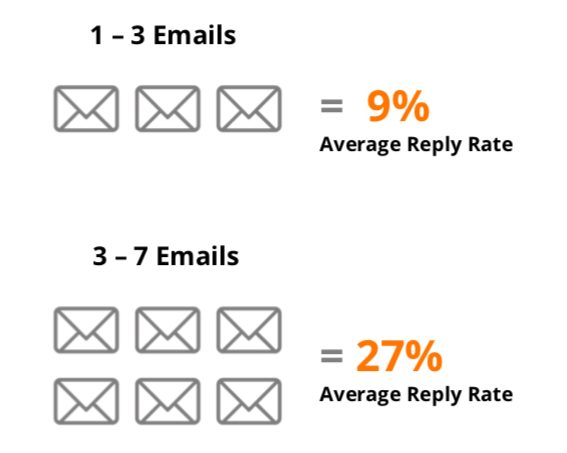Outbound Tips & Tools to Help Scale Your Sales

Countless challenges are faced every day in Outbound sales. Starting with identifying the right prospects, knowing where to find them, and making sure your email outreach grabs your prospect’s attention from the dozens that are landing daily in their inbox.
Yet, the biggest challenge by far is how to do all of the above – at scale. By scaling your sales activities, you cast a much wider net, while staying focused on the most worthwhile prospects. Fortunately, there are loads of accessible tips and tools that can help you refine your outbound sales while scaling these activities to reach even more prospects.
Read on to find out how you can scale your sales and your success:
- Define your target audience
- Finding the right prospect & email address
- Craft the right message
- More Emails = More Replies
- Automate Your Email Communications
- Tracking & Reporting
#1 Define your target audience
All sales activity begins here. The first step is to define your target audience. Make sure you have a deep understanding of what prospects you are going after.
You can start by answering these two questions:
- What type of company do you want to approach? Narrow down your audience by focusing on companies that meet your criteria: industry, number of employees, revenue, region and more. For example, if you are targeting large financial institutions, you will naturally focus on companies that exceed a certain size.
- Who are the key decision makers in the organization? Specify the job titles or roles of the people you need to approach within the organization. Whether it’s the CMO, VP of Marketing, or Sales Manager, make sure you are hitting the right target. You don’t want to waste time and effort or worst be considered as spam.
#2 Finding the right prospect & email address
Now that you know who you are looking for, you just need to find out who exactly is the right prospect and their email address.
Don’t get overwhelmed! Here are a few pointers on how to start:
- LinkedIn: This is the first and easiest place to start. With over 500 million users, you are bound to find the people you need. Search by company and browse the various position holders. Alternatively, visit the websites of the relevant companies, and check out the team bio section. Between these two sources, you are likely to get the information you need.
- Email finder tools: There are tons of email finder services, such as Norbert, Hunter.io, and Seamless.ai. Most offer a free trial or credits, so you can see if it’s right for you before making a commitment.
- Email address formulas: What if you find the right person, but can’t seem to locate their email address? Here’s a neat trick for you: Most companies use email addresses based on a first name/last name combination for the entire company. There are variations, however, with a bit of trial and error, you can often hit the jackpot. For example, many companies use this formula: firstname.lastname@company.com. Once you determine the right combination, simply plug in the first and last names, and you’ve got the email address. With this tactic, you can pretty much reach out to anyone – as long as you know their name!
Bonus tip! Want to boost your chances of getting a response to your emails? Reach out to at least 2 prospects at the same time.
#3 Craft the right message
This is probably the toughest – and most important – part of the outbound sales process. The email is often your first point of contact with the client, so it’s critical to get the tone and content right.
Here are a few tips to help you get there:
- Consider which message would appeal most to the person you are reaching out to. What does their day look like? What are their issues and interests? Try to step into their shoes for a few moments, and see the world as they see it.
- Get realistic about your product or service. What is your value proposition? Why should the customer be interested in working with you? What’s in it for them?
- Personalize, personalize, personalize! You want the customer to feel important. They need to know you did your research, and this is not just a mass email blast.
- Name drop! Mention competitors who are already working with you. A bit of FOMO never hurts.
- Think outside the box – and A/B test. Don’t do the same thing over and over if there’s room for improvement. Try out different approaches to see if you can bring up your reply rates. For example, go short & sweet vs. long and detailed emails. Or serious vs casual tone. Plain text vs. HTML. The possibilities are endless.
#4 More Emails = More Replies
So you’ve sent an email (or two) and received no response. Now what? On the one hand, you don’t want to appear pushy or flood the person’s inbox. On the other hand, you need to be assertive.
Take a look at these stats:

The more emails you send, the more replies you are likely to receive. That’s logical. But in practice, following up it’s not that simple. Here are two tips when following up with a prospect:
- Don’t assume that the prospect read your first email and wasn’t interested. They may simply have missed it. Resend with a more catchy subject line to grab their attention.
- Think about your own inbox – it can get pretty cluttered. People don’t prioritize or respond to emails that don’t interest them. Try to recraft your email for a better shot.
The lesson? Don’t give up!
5. Automate Your Email Communications
The beauty of account-based sales and marketing is that you can scale your efforts and reach the maximum number of true prospects. The downside is that with so many emails to manage, it can become confusing. When you get to a point that it’s impossible to handle one-to-one communication with so many leads at once, find a platform to help automate this process.
There’s tons of sales engagement platforms out right now, like YesWare, Outreach.io, and Salesloft. Shop around to find the one that works for the needs of you and your sales team.
6. Tracking & Reporting
The only way to get a real picture of what’s going on is by tracking and reporting. Looking at email metrics like open rates and reply rates is extremely important in order to make improvements in your outbound strategy. Make sure you catch any trends!
Having your CRM up to date at all times is also key. Syncing all activity under accounts and contacts will give you full visibility on your sales pipeline. This will also help you make sure you are aware of which accounts you have already prospected, which ones you have closed, and which accounts you need to give some breathing room before contacting them again.
Outbound sales is a marathon, not a sprint. Building results take time and perseverance. There’s also a fair amount of trial and error involved. If something’s not working, try a different approach. Take a longer-term perspective, and don’t let the small rejections get you down. With the right message, delivered to the right person at the right time, today’s “no” may well turn into tomorrow’s “yes”.













